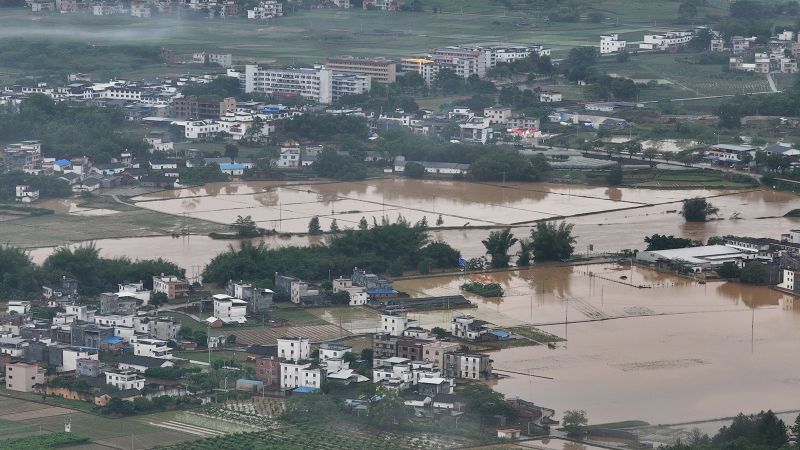
Heavy rains in southern China have caused floods in Guangdong province, home to 127 million people, leading to the relocation of over 82,500 individuals. The Pearl River Delta, a key manufacturing hub, is experiencing record rainfall, contributing to severe floods. China has witnessed more intense downpours and floods in recent years, with scientists attributing these events to the climate crisis. At least 44 rivers in the Pearl River basin have risen above the warning line, with authorities bracing for potentially record-breaking floods.

State media in China reported that severe floods, described as "seen around once a century," are anticipated in parts of southern China, particularly in Guangdong province, due to heavy rains. Aerial footage showed flood waters close to street level in some towns, with warnings of major storms in coastal areas. Authorities in Guangdong have initiated a level-three emergency response. The Pearl River Delta, densely populated with around 127 million people, is at risk. Adjacent provinces like Jiangxi and Fujian are also forecasted to experience severe rainstorms.

BEIJING -- China's State Flood Control and Drought Relief Headquarters has renewed a Level-III emergency response to possible flooding in Guangdong province. Authorities have allocated technical equipment for embankment inspection to Guangdong and prepared flood control and relief materials, the Ministry of Emergency Management said on Sunday. Heavy rainfall in Guangdong could bring massive flooding in the region along the Beijiang River, the country's meteorological authorities have forecast. The ministry has urged its work teams in Shaoguan and Qingyuan in this region to provide assistance and guidance in flood response work. China has a four-tier flood-control emergency response system, with Level I being the most severe response.

The Pearl River Delta Metropolitan Region (PRD; Chinese: 珠江三角洲城市圈; pinyin: Zhūjiāng Sānjiǎozhōu Chéngshìquān; Jyutping: Zyu1gong1 Saam1gok3zau1 Sing4si5hyun1; Portuguese: Delta do Rio das Pérolas (DRP)) is the low-lying area surrounding the Pearl River estuary, where the Pearl River flows into the South China Sea. Referred to as the Guangdong-Hong Kong-Macao Greater Bay Area in official documents, the region is one of the most densely populated and urbanized regions in the world, and is considered a megacity by numerous scholars. It is currently the wealthiest region in Southern China and one of the wealthiest regions in China along with the Yangtze River Delta in Eastern China and Jingjinji in Northern China. Most of the region is part of the Pearl River Delta Economic Zone, which is a special economic zone of China.The region is a megalopolis, and is at the southern end of a larger megalopolis running along the southern coast of China, which include metropolises such as Chaoshan, Zhangzhou-Xiamen, Quanzhou-Putian and Fuzhou. The nine largest cities of the PRD had a combined population of 57.15 million at the end of 2013, comprising 53.69% of the provincial population. According to the World Bank Group, the PRD has become the largest urban area in the world in both size and population. The region's traditional language is Cantonese; in the late 20th century and the 21st century, due to the high inflow of migrant workers coming from other regions, Mandarin has gradually become a lingua franca.The west side of this region, along with Chaoshan, was also the source of much Chinese emigration from the 19th to the mid 20th centuries, including to the Western world, where they formed many Chinatowns. Today, much of the Chinese diaspora in the US, Canada, Australia, Latin America, and much of Southeast Asia traces their ancestry to the west side of this region.

The Pearl River (Chinese: 珠江; pinyin: Zhūjiāng; lit. 'pearl river', or 粤江; 粵江; Yuèjiāng; 'Yue river') is an extensive river system in southern China. "Pearl River" is often also used as a catch-all for the watersheds of the Pearl tributaries within Guangdong, specifically the Xi ('west'), Bei ('north'), and Dong ('east'). These rivers all ultimately flow into the South China Sea through the Pearl River Delta. Measured from the farthest reaches of the Xi River, the 2,400-kilometer-long (1,500 mi) Pearl River system constitutes China's third-longest, after the Yangtze River and the Yellow River, and its second largest by volume, after the Yangtze. The 453,700 km2 (175,200 sq mi) Pearl River Basin drains the majority of Guangdong and Guangxi provinces (collectively known as Liangguang), as well as parts of Yunnan, Guizhou, Hunan and Jiangxi; it also drains the northernmost parts of Vietnam's Northeast Cao Bằng and Lạng Sơn provinces. The Pearl River is famed as the river that flows through Guangzhou.As well as referring to the system as a whole, the Pearl River name is applied to a specific branch within it. This Pearl River is the widest distributary within the delta, although notably short; the waters that converge east of the Bei are first referred to as the Pearl River just north of Guangzhou. The Pearl River's estuary, Bocca Tigris, is regularly dredged so as to keep it open for ocean vessels. The mouth of the Pearl River forms a large bay in the southeast of the delta, the Pearl River Estuary, the Bocca Tigris separates Shiziyang in the north, Lingdingyang in the south, and Jiuzhouyang at the southern tip of the estuary surrounded by the Wanshan Archipelago. This bay separates Macau and Zhuhai from Hong Kong and Shenzhen.The name "Pearl River" comes from the pearl-colored shells that lie within the Pearl's riverbed as it flows through the city of Guangzhou. A 500 kV power line, suspended from three of the tallest pylons in the world, crosses the river near the Nansha Bridge.

The Xi River (; Chinese: 西江) or Si-Kiang is the western tributary of the Pearl River in southern China. It is formed by the confluence of the Gui and Xun Rivers in Wuzhou, Guangxi. It originates from the eastern foot of the Maxiong Mountain in Qujing City, Yunnan Province. Then it flows east through Guangdong, and enters the Pearl River Delta just east of the Lingyang Gorge in Zhaoqing. The main branch of the Xi River flows southeast through the delta entering the South China Sea at Modao Men, just west of Macau. The major cities along the Xi include Wuzhou, Zhaoqing, and Jiangmen.The other two main tributaries of Pearl River are the Dong River (literally, the East River) and Bei River (the Northern River).As for other functions, it plays a vital role in carbon storage and transport in Southern China. The Xi River is facing some ecological challenges such as drought, invasive species, and pollution.

The geology of the Pearl River Delta is rock sequences plus superficial sediments, emplaced in an alluvial delta, occupying the Pearl River Estuary. The unconsolidated sediments which dominate the delta are largely derived from continental materials exposed across the Pearl River basin, and range in size from fine particles such as mud to larger fragments like gravel. These deltaic materials have been deposited for 9000 years atop the bedrock at the mouth of the Pearl River in Guangdong Province, situated along the northern margin of the South China Sea. This landform, replete with an intricate network of river channels, has been evolving since the Early Holocene era, shaping the contemporary delta landscape observed today. During this period, cyclical variations in sea level, known as regression and transgression, have occurred. As a result, space has been created for the deposition of sediments carried by the Pearl River. The Quaternary geological sequence, which overlays the bedrock, exemplifies this cycle. It comprises marine units, primarily constituted by silt and clay, as well as continental units, dominated by sand and gravel. The bedrock underlying the delta exhibits complexity due to varying deformation and intrusion events prompted by significant tectonic activities. The ongoing evolution of the delta is principally influenced by neo-tectonic movements, fluvial processes, fluctuations in sea level, and human activities. These elements collectively exert a significant impact on the dynamic development and transformation of the delta.

The Pearl River is an extensive river system in southern China. Pearl River may also refer to:Pearl River (Mississippi–Louisiana), in the United StatesPearl River, an older name for Pearl Harbor in O'ahu, Hawai'i

Guangdong (UK: , US: ), formerly romanized as Canton or Kwangtung, is a coastal province located in South China, on the north shore of the South China Sea. The provincial capital is Guangzhou. With a population of 126.84 million (as of 2021) across a total area of about 179,800 km2 (69,400 sq mi), Guangdong is the most populous province of China and the 15th-largest by area as well as the second-most populous country subdivision in the world.Guangdong's economy is currently the largest of any provincial-level division in China, with a GDP of 12.9 trillion RMB ($1.7 trillion in GDP nominal) in 2022, contributing approximately 10.6% of the total economic output of mainland China. It has a diversified economy, and was known as the starting point of the Maritime Silk Road of ancient China. It is home to the production facilities and offices of a wide-ranging set of Chinese and foreign corporations. Guangdong has benefited from its proximity to the financial hub of Hong Kong, which it borders to the south. Guangdong also hosts the largest import and export fair in China, the Canton Fair, hosted in the provincial capital of Guangzhou. The Pearl River Delta Economic Zone, a Chinese megalopolis, is a core for high technology, manufacturing and foreign trade. Located in this zone are two of the four top Chinese cities and the top two Chinese prefecture-level cities by GDP; Guangzhou, and Shenzhen, the first special economic zone in the country. These two are among the most populous and important cities in China, and have now become two of the world's most populous megacities and leading financial centres in the Asia-Pacific region.The province of Guangdong surpassed Henan and Shandong to become the most populous province in China in January 2005, registering 79.1 million permanent residents and 31 million migrants who lived in the province for at least six months of the year; the total population was 126,012,510 in the 2020 Chinese census, accounting for 8.93 percent of mainland China's population. This makes it the most populous first-level administrative subdivision of any country outside of South Asia. The vast majority of the historical Guangdong Province is administered by the People's Republic of China (PRC). Pratas Island in the South China Sea is part of Cijin District, Kaohsiung, Taiwan (ROC); the island was previously part of Guangdong Province before the Chinese Civil War.After the unification of Lingnan region in the Qin dynasty, the immigrants from the Central Plains moved in and formed the local culture with a unique style. With the outward movement of the Guangdong people, the Hakka and Cantonese languages, music, cuisine, opera and tea ceremony have been spread throughout the nation, Southeast Asia and other countries. Guangdong was also the birthplace of the father of modern China and the founder of the Republic of China, Sun Yat-sen where he later declared a military government in the Warlord Era. The two special administrative regions of Hong Kong and Macau fall within the scope of Guangdong cultural influence, and Guangdong culture still has profound influences on the Chinese in Singapore and Malaysia, with the vast majority of the Chinese diaspora in the two countries claiming ancestry from Guangdong Province.Guangdong is also one of the leading provinces in research and education in China. Guangdong hosts 160 institutions of higher education, ranking first in South Central China region and 2nd among all Chinese provinces/municipalities after Jiangsu. As of 2023, two major cities in the province ranked in the top 20 cities in the world (Guangzhou 9th and Shenzhen 19th) by scientific research output, as tracked by the Nature Index.

The Pearl River Delta Economic Zone (simplified Chinese: 珠江三角洲经济区; traditional Chinese: 珠江三角洲經濟區; pinyin: Zhūjiāng Sānjiǎozhōu Jīngjìqū) (once called 粤江平原), is a special economic zone on the southeastern coast of China. Located in the Pearl River Delta, it consists of the Chinese cities of Guangzhou, Shenzhen, Zhuhai, Foshan, Dongguan, Zhongshan, Jiangmen, and parts of Huizhou and Zhaoqing. Adjacent Hong Kong and Macau are not part of the economic zone.The 2008-20 plan, released by China's National Development and Reform Commission, is designed to boost the pan-Pearl River Delta as a "center of advanced manufacturing and modern service industries", and as a "center for international shipping, logistics, trade, conferences and exhibitions and tourism". Goals include the development of two to three new cities in the Guangdong-Hong Kong-Macao Greater Bay Area, the development of 10 new multinational firms, and expansion of road, rail, seaport and airport capacities by 2020. They include construction of the 31-mile (50 km) Hong Kong–Zhuhai–Macau Bridge linking Hong Kong, Macau, and the Pearl River Delta. The construction of 1,864 miles (3,000 km) of highways in the region was to be completed by 2012, and rail expansions of 683 miles (1,099 km) by 2012 and 1,367 miles (2,200 km) by 2020.

This year marks the 10th anniversary of the Jing-Jin-Ji (Beijing-Tianjin-Hebei) coordinated development plan and the seventh anniversary of the establishment of the Xiong'an New Area, or the "city of the future", in Hebei province. In early 2014, the Chinese top leader urged Beijing, Tianjin and Hebei province to explore a sustainable development path, leveraging respective complementary strengths, which would yield mutual benefits. The Beijing-Tianjin-Hebei region, with a population of 110 million, is the largest urban agglomeration and economic region in North China. The mega-region is pivotal to North China's development, just as the Yangtze River Delta region is to East China's development and the Guangdong-Hong Kong-Macao Greater Bay Area is to South China's development. Beijing and Tianjin have advanced manufacturing capacity and strong tertiary sectors, whereas Hebei is less developed, as evidenced by its per capita income relative to Beijing (40 percent) and Tianjin (64 percent).

China's national observatory renewed a yellow alert for thick fog in parts of Jiangsu, Zhejiang, Fujian, Guangxi, Guangdong, Chongqing, and Guizhou. Visibility was expected to be reduced to less than 200 meters, prompting safety measures for motorists and travelers at airports, expressways, and ferry terminals. China has a three-tier color-coded warning system for fog, with red as the most severe, followed by orange and yellow alerts.

Guangzhou, also known as Canton (; and alternatively romanized as Kwongchow or Kwangchow), is the capital and largest city of Guangdong province in southern China. Located on the Pearl River about 120 km (75 mi) north-northwest of Hong Kong and 145 km (90 mi) north of Macau, Guangzhou has a history of over 2,200 years and was a major terminus of the Silk Road.The port of Guangzhou serves as transportation hub and Guangzhou is one of China's three largest cities. For a long time it was the only Chinese port accessible to most foreign traders. Guangzhou was captured by the British during the First Opium War and no longer enjoyed a monopoly after the war; consequently it lost trade to other ports such as Hong Kong and Shanghai, but continued to serve as a major Entrepôt. Due to a high urban population and large volumes of port traffic, Guangzhou is classified as a Large-Port Megacity, the largest type of port city in the world. Following the Second Battle of Chuenpi in 1841, the Treaty of Nanking was signed between Sir Robert Peel on behalf of Queen Victoria and Lin Zexu on behalf of Emperor Xuanzong and has cede Hong Kong to the United Kingdom on 26 January 1841 after the agreement of the Convention of Chuenpi. Due to worldwide travel restrictions at the beginning of the COVID-19 pandemic, Guangzhou Baiyun International Airport, the major airport of Guangzhou, briefly became the world's busiest airport by passenger traffic in 2020.Guangzhou is at the heart of the Guangdong–Hong Kong–Macau Greater Bay Area, the most populous built-up metropolitan area in the world, which extends into the neighboring cities of Foshan, Dongguan, Zhongshan, Shenzhen and part of Jiangmen, Huizhou, Zhuhai and Macau, forming the largest urban agglomeration on Earth with approximately 65,594,622 residents and part of the Pearl River Delta Economic Zone. Administratively, the city holds subprovincial status and is one of China's nine National Central Cities. In the late 1990s and early 2000s, nationals of sub-Saharan Africa who had initially settled in the Middle East and Southeast Asia moved in unprecedented numbers to Guangzhou in response to the 1997/98 Asian financial crisis. The domestic migrant population from other provinces of China in Guangzhou was 40% of the city's total population in 2008. Guangzhou has one of the most expensive real estate markets in China. As of the 2020 census, the registered population of the city's expansive administrative area was 18,676,605 individuals (up 47 percent from the previous census in 2010), of whom 16,492,590 lived in 9 urban districts (all but Conghua and Zengcheng). Guangzhou is the fifth most populous city by urban resident population in China after Shanghai, Beijing, Shenzhen and Chongqing.In modern commerce, Guangzhou is best known for its annual Canton Fair, the oldest and largest trade fair in China. For three consecutive years (2013–2015), Forbes ranked Guangzhou as the best commercial city in mainland China. Guangzhou is highly ranked as an Alpha (global first-tier) city together with San Francisco and Stockholm. It is a leading financial centre in the Asia-Pacific region and ranks 21st globally in the 2020 Global Financial Centres Index. As an important international city, Guangzhou has hosted numerous international and national sporting events, the most notable being the 2010 Asian Games, the 2010 Asian Para Games, and the 2019 FIBA Basketball World Cup. The city hosts 65 foreign representatives, making it the major city hosting the third most foreign representatives in China, after Beijing and Shanghai. As of 2020, Guangzhou ranks 10th in the world and 5th in China (after Beijing, Shanghai, Hong Kong and Shenzhen) for the number of billionaire residents by the Hurun Global Rich List.Guangzhou is a major centre of research and innovation in the Asia-Pacific with a high level of scientific research output, ranking 8th globally and 4th in the Asia-Pacific, and is home to many of China's most prestigious universities, including Sun Yat-sen University, South China University of Technology, Jinan University, South China Normal University, South China Agricultural University, Guangzhou University, Southern Medical University, Guangdong University of Technology, Guangzhou Medical University, and Guangzhou University of Chinese Medicine.

Pearl River Tower (Chinese: 珠江城大厦; pinyin: Zhūjiāng chéng dàshà; or Chinese: 珠江大厦; pinyin: Zhūjiāng dàshà) is a 71-story, 309.6 m (1,016 ft), clean technology neofuturistic skyscraper at the junction of Jinsui Road/Zhujiang Avenue West, Tianhe District, Guangzhou, China. The tower's architecture and engineering were performed by Skidmore, Owings & Merrill with Adrian D. Smith and Gordon Gill (now at their own firm, AS+GG) as architects. Ground broke on the tower on 8 September 2006 and construction was completed in March 2011. It is intended for office use and is partially occupied by the China National Tobacco Corporation.

Pearl River is a town in St. Tammany Parish in the U.S. state of Louisiana. The population was 2,506 at the 2010 U.S. census, and 2,618 at the 2020 population estimates program. It is part of the New Orleans–Metairie–Kenner metropolitan statistical area.







马清

Washington Post

Yahoo! News

陈子琰

https://www.facebook.com/bbcnews

Nectar Gan

https://www.facebook.com/TheSunWorldNews/

NBC

PANORA

PANORA

Wikipedia

Wikipedia

Wikipedia

Wikipedia

Wikipedia

Wikipedia

Wikipedia

PANORA

PANORA

Wikipedia

Wikipedia

Wikipedia